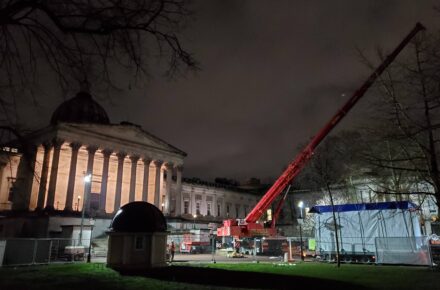

(Credit: UCL Media Services via Imagestore)
The UCL Art Museum has been told to vacate its current premises in the South Cloisters next month to make way for the bicentenary works that will see the Main Quad and Cloisters shut until at least 2026.
Under proposals submitted to Camden Council, the University intends to rehaul the Wilkins Building and convert the Art Museum into a ‘multipurpose room’.
However, UCL has not confirmed where the Art Museum would be relocated and as such has been described bluntly by multiple sources as an ‘eviction’.
Sources familiar with the matter – none of whom were willing to speak on the record – pointed to a ‘culture of not being able to speak out’ as UCL attempts to create the illusion of a ‘celebratory vibe’ around the bicentenary works.
The Cheese Grater understands that there is now a prevailing sense of uncertainty among staff and students involved in UCL’s various museums, a number of whom noted that they did not feel ‘respected or valued’ by the University.

Just yesterday, Emeritus Professor of the History of Art David Bindman told The Observer that the proposals pay ‘no attention to the museum as a secure space and a controlled environment. You can’t combine a museum with precious objects and an open space.’
A letter was reportedly addressed to the University in which staff expressed ‘deep concern regarding plans to decant UCL Art Museum in November’ and warned that ‘UCL is seriously risking its reputation’.
In September, Bindman also lodged an objection to Camden Council where he criticised the University’s plan to ‘put everything in store with no proposed location for its redisplay.’
‘Apart from the unspecified length of storage, a whole new space would have to be found that is highly unlikely to be as easy of access as the present room, as well as the dangers of packing them up in the first place.’
He added, ‘I am sure it is coincidental that this proposal was rushed through during the long vacation, but it is clear that wide consultation within the College had not taken place.’
UCL’s internal consultation on the building proposals, dubbed the ‘Estates Masterplan’, lasted from late April to early August.
It is unclear how many responses were received, although sources have echoed Bindman’s concern about the timing of the consultation, which coincided with exams season and the summer break.
Many of those we spoke to have lamented the imminent loss of the Art Museum, a globally significant and popular interdisciplinary teaching space.
To understand why the Art Museum’s eviction had amassed such strong opposition, The Cheese Grater spoke to the Petrie Museum about the significance of teaching museums at UCL.

‘Museums at UCL are a special place’, it said, noting that UCL’s museums are national and globally recognised institutions housing ‘world-standard’ collections, ranging from the world’s oldest woven garment in the Petrie Museum, the Orwell archives in the Special Collections, the artworks of Turner and Rembrandt in the Art Museum, to the jar of moles in the Grant Museum.
‘There is something in here for everyone, and every conversation can be enriched through the use of collections’. It added, ‘It’s an alternative way of exploring the world and how to interact with it that… isn’t really offered anywhere else on campus, and that isn’t really offered in many universities.’
The Museum was also keen to stress that the spaces, not just the collections, are there for students, and as such are ‘trying our best to engage with student societies, to ask students what they want, and directly deliver on that in a way that other departments don’t necessarily do.’
The Petrie Museum recently screened a student-led production Flinderella, a modern rendition of the satirical pantomime first performed in the museum in 1923, taking a critical perspective on issues in archaeology past and present.
One staff member involved in the production said, ‘Museums are not neutral spaces. They are spaces of power and prestige… We want these to be spaces where critical thoughts are voiced.’
The Petrie Museum is expected to relocate soon as part of the same Estates Masterplan that had placed the Art Museum on the firing line, with no word from the University on where they would be going.

Rather than celebrating the museums’ global reputation in object-based learning, sources have criticised UCL for its laser focus on space utilisation to ‘meet market demand’, according to its 2022-27 Strategy Plan, with one source describing the Estates Masterplan as the University ‘trying to play Tetris with the campus’ to see whatever fits best in the most efficient way possible.
‘UCL has this amazing reputation globally, but it is the staff and the students that make it so, not UCL,’ said another.
It is unclear if management understands this.
A UCL spokesperson said,
‘As part of a significant redevelopment project we are transforming UCL’s iconic Quad, along with its surrounding buildings, to ensure our central London campus is a more sustainable, accessible and inclusive place for all our students, staff and visitors. These improvements will help preserve the history of spaces at UCL, while making them more functional and usable, enhancing UCL’s estate ahead of our Bicentenary in 2026.
‘While the Art Museum will be temporarily closed its collections are being carefully stored and can still be accessed for research, teaching and for open days. In the longer-term we aim to provide new gallery and exhibition space, so our students and the public have better access to these important art works.’
This article appeared in the Digestive 3








